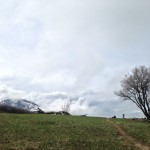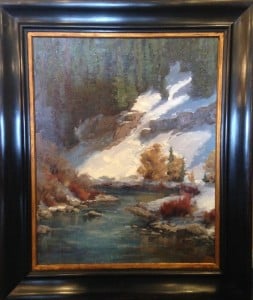This might have the appearance as one of the easiest, dare I say natural, aphorisms of Doc’s, since appreciation of this sort would appear easy to come by. I have never met a person who did not have at least a modicum of respect for natural beauty of some kind. So it is curious, then, that much rarer are those individuals whose attachment to beauty is deep enough to forge a lasting commitment to the health and wellbeing of their surroundings. I have said it before, but fierce affection for nature without due attention to its health and flourishing is akin to pornographic desire because it is more interested in gratification than service and sanctification.
That is merely to say that Doc holds us to a much higher standard than we might at first think. The truth is, it hasn’t exactly been easy over the course of human history to find beauty in ordinary nature. One look at the history of art is sufficient to realize that it wasn’t at least until the Renaissance that we began to see images of somewhat ordinary landscapes in paintings and as late as the early nineteenth century when we saw them finally unadorned by the whimsical imaginations of the artist or by the weight of mythology and history that art critics demanded of landscape paintings. In their long battle for supremacy with the poets, painters had convinced themselves that painting wasn’t a high art unless it was philosophy and it wasn’t philosophy if it didn’t embellish on reality. We spent the better part of Western history, in other words, believing that nature needed artistic enhancement to be beautiful. But once we finally began in earnest to let go of these pretensions, we found we were scarcely up to the task. The Impressionists alone are proof that reality is inexhaustible and inexhaustibly beautiful. We now know, or at least we should, that we are always playing catch up to the wonder of this world.
Doc is not describing exotic locales, the likes of which we might see on a cruise or an excursion, but the simple and mundane places that most immediately surround us. If you have seen the film, “The Tree of Life,” then you know what kind of deeper perception of beauty is required in order to imagine that the trees of one’s childhood or neighborhood—in the case of the film the trees of Waco, Texas—could be seen as the trees of eternal life, or at least as portals into heaven. The film so lovingly passes through, passes by, and passes underneath these trees while sacred music plays, one feels that it is a wonder that we don’t all drop what we are doing and stare. One telling phrase from the LDS account of the creation should haunt us: “And out of the ground made I, the Lord God, to grow every tree, naturally, that is pleasant to the sight of man; and man could behold it. And it became also a living soul” (Moses 3:9). Aesthetic value is primary here. Sure, we are told that Adam and Eve discover that trees are useful for food, for fuel, and for shelter (and we now know they are central players in the regulation of the climate), but they are first and foremost something wonderful to behold. This is their gift and our privilege. True too, of course, of the fields and brooks of which Doc speaks. Elegant in their simplicity, strange in their familiarity, spiritual in their physicality, the earth and its many forms challenge us to find language, culture, and lifeways adequate to the mystery of what it means to be alive in the body.
In 2004, a colleague and I interviewed the novelist, Marilynne Robinson, and at one point, almost improvising on the spot, she dropped this gem:
It seems to me as if every local landscape is a version of the cosmic mystery, that it is very strange that we’re here, and that it is very strange that we are what we are. In a certain sense the mystery of the physical reality of the human being is expressed in any individual case by the mystery of a present landscape. The landscape is ours in the sense that it is the landscape that we query. So, we’re created in the fact of ourselves answering to a particular sense of amazement…. One of the ways that they have of hiding from human reality is to create artificial environments. Look at people from Babylon forward; when people have power they create an artificial environment around themselves that can suggest to them that they’re immune from the consequences of being mortal. And palaces, all these things, are monuments to this impulse…. to the point [now] that we have no idea where we are by looking at what surrounds us.
Much here to consider, but I would highlight one notion in particular. She says that we are “created” in the act of “answering to a particular sense of amazement.” This astonishment, in other words, is what makes us human. If no success can compensate for failure in the home, I am tempted to say that neither can any success indoors compensate for a failure to be amazed at what lies outdoors. Why is this? Just ask Job. For one thing, such amazement places us in proper perspective. As I have written hereand there, like Job and Moses we can really only understand our significance as a kind of nothingness. Once we understand ourselves as interdependent not only with each other but with all of life, as part of something much grander, much more complex and vast and diverse than our puny human interests, we begin to comprehend how strange and unnecessary beauty really is, as strange and as unnecessary as love or grace or forgiveness and mercy. And when we see them unnecessary but nevertheless real, we see them as gifts of a Giver. Such awareness most meaningfully begins in a home landscape.
A word about recreation is needed here too. Doc doesn’t mention ATVs, boats, or cruise ships. He had lived to see the explosion of interest in recreation that began after World War II and that hasn’t stopped in its many commercialized advancements. We are all seeking our paradise on earth, only now instead of working for it, we want to buy it or mechanize our relationship to it. 50 years ago the average visit to the Grand Canyon was two weeks. Now it is closer to two hours. As I intended to thematize in Home Waters, recreation and affection for nature are no panacea for the environmental problems we face. As Wallace Stegner made clear, we can love a place and still be dangerous to it, and this is due in no small measure to our method of relying on wasteful technologies instead of on our own bodies. (It doesn’t help that we now know too that the small engines that propel most recreational machines are exponentially more wasteful and damaging to the environment than larger engines, making an hour of use in many cases the equivalent of using a full tank of gas in an automobile.) Yet again Doc suggests that we would do well if we could learn to simplify the way we enjoy nature. Being physically present in it—walking, hiking, rowing—makes our bodies work to earn our reward of coming closer to the earth’s allure and teaches us something of the rhythms of a place.
In the end, superficial exposure to nature, as if at a diorama, doesn’t captivate us enough to change our rushed and mechanized lives and inspire better care of the world. I don’t mean to sound redundant, but it was at Doc’s Boys Ranch in Teton Valley at the age of 12 when I really entered my embodied existence and discovered the value of physical work and of physical recreation. I discovered that the gift of embodiment, the gracious gift of life itself, gave me the unique privilege and responsibility to serve, build, care for, and experience the world. Not much else seemed to matter, and not much else matters still.











